Hospital ship
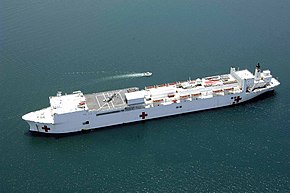
A hospital ship is a ship designated for primary function as a floating medical treatment facility or hospital. Most are operated by the military forces (mostly navies) of various countries, as they are intended to be used in or near war zones.[1] In the 19th century, redundant warships were used as moored hospitals for seamen.
The Second Geneva Convention prohibits military attacks on hospital ships that meet specified requirements, though belligerent forces have right of inspection and may take patients, but not staff, as prisoners of war.[2][3]
History
[edit]Early examples
[edit]
Hospital ships possibly existed in ancient times. The Athenian Navy had a ship named Therapia, and the Roman Navy had a ship named Aesculapius, their names indicating that they may have been hospital ships.[4][5][6]
The earliest British hospital ship may have been the vessel Goodwill, which accompanied a Royal Navy squadron in the Mediterranean in 1608 and was used to house the sick sent aboard from other ships.[7] However this experiment in medical care was short-lived, with Goodwill assigned to other tasks within a year and her complement of convalescents simply left behind at the nearest port.[8] It was not until the mid-seventeenth century that any Royal Navy vessels were formally designated as hospital ships, and then only two throughout the fleet. These were either hired merchant ships or elderly sixth rates, with the internal bulkheads removed to create more room, and additional ports cut through the deck and hull to increase internal ventilation.[7]
In addition to their sailing crew, these seventeenth century hospital ships were staffed by a surgeon and four surgeon's mates. The standard issue of medical supplies was bandages, soap, needles and bedpans. Patients were offered a bed or rug to rest upon, and given a clean pair of sheets. These early hospital ships were for the care of the sick rather than the wounded, with patients quartered according to their symptoms and infectious cases quarantined from the general population behind a sheet of canvas. The quality of food was very poor. In the 1690s, the surgeon aboard Siam complained that the meat was in an advanced state of putrefaction, the biscuits were weevil-ridden and bitter, and the bread was so hard that it stripped the skin off patients’ mouths.[7]
Hospital ships were also used for the treatment of wounded soldiers fighting on land. An early example of this was during an English operation to evacuate English Tangier in 1683. An account of this evacuation was written by Samuel Pepys, an eyewitness. One of the main concerns was the evacuation of sick soldiers "and the many families and their effects to be brought off". The hospital ships Unity and Welcome sailed for England on 18 October 1683, with 114 invalid soldiers and 104 women and children, arriving at The Downs on 14 December 1683.[9]
The number of medical personnel aboard Royal Navy hospital ships was slowly increased, with regulations issued in 1703 requiring that each vessel also carry six landsmen to act as surgical assistants, and four washerwomen. A 1705 amendment provided for a further five male nurses, and requisitions from the era suggest the number of sheets per patient was increased from one to two pairs.[7] On 8 December 1798, unfit for service as a warship, HMS Victory was ordered to be converted to a hospital ship to hold wounded French and Spanish prisoners of war. According to Edward Hasted in 1798, two large hospital ships (also called lazarettos), (which were the surviving hulks of forty-four gun ships) were moored in Halstow Creek in Kent. The creek is an inlet from the River Medway and the River Thames. The crew of these vessels watched over ships coming to England, which were forced to stay in the creek under quarantine to protect the country from infectious diseases including the plague.[10]
From 1821 to 1870, the Seamen's Hospital Society provided HMS Grampus, HMS Dreadnought and HMS Caledonia (later renamed Dreadnought) as successive hospital ships moored at Deptford in London.[11] In 1866, HMS Hamadryad was moored in Cardiff as a seamen's hospital, replaced in 1905 by the Royal Hamadryad Seamen's Hospital.[12] Other redundant warships were used as hospitals for convicts and prisoners of war.
Modern hospital ships
[edit]
The Royal Navy institutionalised the use of hospital ships during the first half of the nineteenth century. Hospital ships were generally superior in their standard of service and sanitation to the medical provision available at the time for convalescent soldiers. The modern hospital ship began to emerge during the Crimean War in the 1850s. The only military hospital available to the British forces fighting on the Crimean Peninsula was at Scutari near the Bosphorus. During the Siege of Sevastopol almost 15,000 wounded troops were transported there from the port at Balaklava by a squadron of converted hospital ships.[9]
The first ships to be equipped with genuine medical facilities were the steamships HMS Melbourne and HMS Mauritius, staffed by the Medical Staff Corps and providing services to the British expedition to China in 1860. The ships provided relatively spacious accommodation for the patients, and were equipped with an operating theatre. Another early hospital ship was USS Red Rover in the 1860s, which aided the wounded soldiers of both sides during the American Civil War.[9]
During the Russo-Turkish War (1877–78), the British Red Cross supplied a steel-hulled ship, equipped with modern surgery equipment including chloroform and other anaesthetics, and carbolic acid for antisepsis. Similar vessels accompanied the 1882 British invasion of Egypt and aided American personnel during the 1898 Spanish–American War.[9]
During a smallpox outbreak in London in 1883, the Metropolitan Asylum Board (MAB) chartered and later purchased from the Admiralty two ships, HMS Atlas and HMS Endymion, and a paddle-steamer, PS Castalia, which were moored in the Thames at Long Reach, near Dartford,[13][14] and remained in service until 1903.[13][15]
Hospital ships were used by both sides in the Russo-Japanese War of 1904–1905.The sighting by the Japanese of the Russian hospital ship Orel, illuminated in accordance with regulations for hospital ships, led to the decisive naval Battle of Tsushima. Orel was retained as a prize of war by the Japanese after the battle.[citation needed]
World Wars
[edit]
During World War I and World War II, hospital ships were first used on a massive scale. Many passenger liners were converted for use as hospital ships. RMS Aquitania and HMHS Britannic were two famous examples of ships serving in this capacity. By the end of the First World War, the British Royal Navy had 77 such ships in service. During the Gallipoli Campaign, hospital ships were used to evacuate wounded personnel to Egypt, Malta or England.[16]
Canada operated hospital ships in both world wars. In World War I these included SS Letitia (I) and HMHS Llandovery Castle which was deliberately sunk by a German U-boat with great loss of life, despite the hospital ship's clearly marked status. In World War II, Canada operated the hospital ship RMS Lady Nelson and SS Letitia (II).[17]

The first purpose-built hospital ship in the U.S. Navy was USS Relief[18] which was commissioned in 1921. During World War II both the United States Navy and Army operated hospital ships though with different purposes.[19] Naval hospital ships were fully equipped hospitals designed to receive casualties direct from the battlefield and also supplied to provide logistical support to front line medical teams ashore.[19] Army hospital ships were essentially hospital transports intended and equipped to evacuate patients from forward area Army hospitals to rear area hospitals or from those to the United States and were not equipped or staffed to handle large numbers of direct battle casualties.[19] Three of the Navy hospital ships, USS Comfort, USS Hope, and USS Mercy, were less elaborately equipped than other Navy hospital ships, medically staffed by Army medical personnel and similar in purpose to the Army model.[19]

The last British royal yacht, the post World War II HMY Britannia, was constructed in a way as to be convertible to a hospital ship in wartime. After her decommissioning, Peter Hennessy discovered that her actual role would have been as Queen Elizabeth II's refuge from nuclear weapons, hiding amidst the lochs of western Scotland.[20]
A development of the Lun-class ekranoplan was planned for use as a mobile field hospital for rapid deployment to any ocean or coastal location at a speed of 297 knots (550 km/h, 341.8 mph). Work was 90% complete on this model, Spasatel, but Soviet military funding ceased and it was never completed.
Some hospital ships, such as SS Hope and Esperanza del Mar, belong to civilian agencies, and do not belong to a navy. Mercy Ships is an international non-governmental charity (or NGO).
International law
[edit]
Hospital ships were covered under the Hague Convention X of 1907.[21] Articles of the Hague Convention X specified the provisions for a hospital ship:
- Hospital-ships must be painted white. Military hospital ships must have a green band; ships operated by approved relief societies and similar must have a red band.
- Ships must fly a red cross flag in addition to their national flag.
- The ship should give medical assistance to wounded personnel of all nationalities.
- The ship must not be used for any military purpose, or interfere with or hamper enemy combatant vessels.
- Belligerents, as designated by the Hague Convention, can search any hospital ship to investigate violations of the above restrictions.
- Belligerents will establish the location of a hospital ship.
According to the San Remo Manual on International Law Applicable to Armed Conflicts at Sea, a hospital ship violating legal restrictions must be duly warned and given a reasonable time limit to comply. If a hospital ship persists in violating restrictions, a belligerent is legally entitled to capture it or take other means to enforce compliance. A non-complying hospital ship may only be fired on under the following conditions:
- Diversion or capture is not feasible
- No other method to exercise control is available
- The violations are grave enough to allow the ship to be classified as a military objective
- The damage and casualties will not be disproportionate to the military advantage.
In all other circumstances, attacking a hospital ship is a war crime.
Modern hospital ships display large Red Crosses or Red Crescents to signify their Geneva Convention protection under the laws of war. Even so, marked vessels have not been completely free from attack. Notable examples of hospital ships deliberately attacked during wartime are HMHS Llandovery Castle in 1915, the Soviet hospital ship Armenia in 1941, and AHS Centaur in 1943.
Current hospital ships
[edit]This section needs expansion. You can help by adding to it. (February 2021) |
While any ship can be designated and marked as a hospital ship, many ships are permanently dedicated to that function.
Current military hospital ships
[edit]| Military hospital ships | |||||
|---|---|---|---|---|---|
| Navy | Ship (class) |
Year | Capacity | Capabilities | Image |
| Brazil |
U15 Pará[citation needed] | 
| |||
| U16 Doutor Montenegro[citation needed] | 
| ||||
| U18 Oswaldo Cruz (Oswaldo Cruz)[citation needed] |
1984 | 
| |||
| U19 Carlos Chagas (Oswaldo Cruz)[citation needed] |

| ||||
| U21 Soares de Meirelles[citation needed] | 2009 | 
| |||
| U28 Tenente Maximiano[citation needed] | 2010 | 
| |||
| China |
Nankang (833) (Qiongsha)[citation needed] |
Classed as an "ambulance transport" | |||
| Zhuanghe (865) | 2004 | Classed as a "medical evacuation ship", converted container ship with 14 "medical modules" | |||
| Daishan Dao (866) (Type 920) |
2008 | 300 hospital beds, 20 intensive care beds | 8 operating theatres, X-ray, ultrasound, CT, hypothermia, hemodialysis, traditional Chinese medicine, and dental facilities | 
| |
| Nanyi (12) (Anshen)[citation needed] |
2020 | Classed as a "medium sized hospital ship" | |||
| tba (13) (Anshen)[citation needed] |
2020 | Classed as a "medium sized hospital ship" | |||
| Indonesia |
KRI dr. Soeharso (990) (Tanjung Dalpele) |
2003 | Former (LPD), capable of receiving up to 2000 patients | 5 operating rooms, 6 polyclinics, 51 medical specialists | 
|
| KRI Semarang (594) (Makassar) |
2018 | 
| |||
| KRI dr. Wahidin Sudirohusodo (991) | 2021[22] | 
| |||
| KRI dr. Radjiman Wedyodiningrat (992)[23] | 2023 | 124 Beds, additional 350 Beds in Emergency Case | 2 ERs, 5 ORs (+ Pre/ Post), ICU, HCU, X-ray & CT-scan, Pharmacy, 8 Polyclinics, and Laboratory. | ||
| Myanmar |
UMS Shwe Pu Zun | 2012 | 25 | 1 CT scanner, 1 minor eye operation room, 1 minor operation theater, 1 major operation theater, and 1 intensive care unit[24][25] | |
| UMS Thanlwin | 2015 | 25 | 1 CT scanner, 1 minor eye operation room, 1 minor operation theater, 1 major operation theater, and 1 intensive care unit[24][25] | ||
| Peru |
BAP Puno | 1976 | Converted 1861 steamship, found on Lake Titicaca | 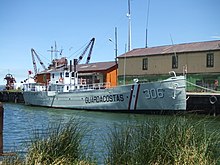
| |
| Russia |
Yenisey (Ob) |
1981 | 100 | 7 operating rooms | 
|
| Svir (Ob) |
1989 | 100 | 7 operating rooms | ||
| Irtysh (Ob) |
1990 | 100 | 7 operating rooms | 
| |
| United States |
USNS Mercy (Mercy) |
1986 | 1,000 | 12 operating rooms, digital radiological services, a medical laboratory, a pharmacy, an optometry lab, an intensive care ward, dental services, a CT scanner, a morgue, 2 oxygen-producing plants | 
|
| USNS Comfort (Mercy) |
1987 | 1,000 | 12 operating rooms, digital radiological services, a medical laboratory, a pharmacy, an optometry lab, an intensive care ward, dental services, a CT scanner, a morgue, 2 oxygen-producing plants | 
| |
| Vietnam |
Khánh Hòa - 01 (Hospital Ship 561)[26] |
2013 | 200 | Operating room with satelline connected, intensive care, pressure isolation room, medical laboratory, treatment room, defibrillator room, dental service, Endoscopic room, pharmacy. radiology. | |
Current non-military hospital ships
[edit]| Agency/NGO | Ship (class) |
Year | Capacity | Capabilities | Image |
|---|---|---|---|---|---|
| Mercy Ships |
MV Africa Mercy | Converted 2007 | 82 | 5 operating theaters, 1 intensive care unit, 1 ophthalmic unit, a CT scanner, x-ray, laboratories[27] | 
|
| MV Global Mercy | 2022 | 199 | 6 operating theatres, 102 acute care beds, 7 ICU beds, and 90 self-care beds. The hospital also features dedicated classroom spaces and simulator labs with state-of-the-art technology for enhanced training of local medical professionals.[28] |  | |
| Ministry of Labour (Spain) |
Esperanza del Mar | 2001 | 17 | 1 operating theatre, ICU facility | 
|
| Juan de la Cosa | 2006 | 10 | 1 operating theatre, ICU facility | 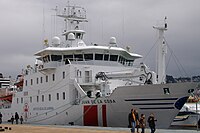
|
Other shipborne hospitals
[edit]It is common for naval ships, especially large ships such as aircraft carriers and amphibious assault ships to have on-board hospitals. However, they are only one small part of the vessel's overall capability, and are used primarily for the ship's crew and its amphibious forces (and occasionally for relief missions). A warship with hospital facilities does not have the protected status of a hospital ship.[29] A primary example of the varied military-based hospital services available at sea is found aboard several types of US naval ships;
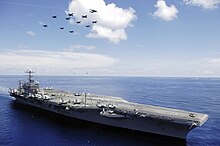
- Gerald R. Ford-class aircraft carrier – USS Gerald R. Ford, first in the class, has an on-board hospital that includes a full lab, pharmacy, operating room, 3-bed intensive care unit, 2-bed emergency room, and 41-bed hospital ward, staffed by 11 medical officers and 30 hospital corpsmen.[30]
- Nimitz-class aircraft carrier – Each carrier has a 53-bed hospital ward, a three-bed ICU, and acts as the hospital ship for the entire carrier strike group.[31] In one year, the medical department of USS George Washington handled over 15,000 out-patient visits, drew almost 27,000 labs, filled almost 10,000 prescriptions, took about 2,300 x-rays and performed 65 surgical operations.[32] There is not much variation among the ships of the class. The first ship, USS Nimitz has 53 beds, plus 3 ICU beds, and the last ship, USS George H.W. Bush has 51 beds, plus 3 ICU beds.[33]
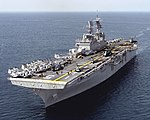
- Wasp-class amphibious assault ship (LHD) – These ships have 6 operating rooms, 14 ICU beds, 46 hospital beds, 4 battle dressing stations, medical imaging (i.e.:X-ray), a fully functional laboratory, and a blood bank.[34] The ship can expand its medical complement to 600 beds, making it the second largest hospital at sea, second only to actual hospital ships.[35]
- America-class amphibious assault ship (LHA) – This is the newest and largest class both in the USN and the world. However, the first two ships of the class, USS America and USS Tripoli, had the size of their medical facilities reduced, in favour of larger aviation facilities.[36] The on-board hospitals of these first two vessels will have 2 operating rooms and 24 beds.[37] It is unknown if this design change will affect the expanded capability for additional beds, nor what size the medical facilities of future ships of the class will be.
- San Antonio-class amphibious transport dock (LPD) – 24 hospital beds.[37]
- Harpers Ferry-class dock landing ship (LSD) – 11 hospital beds.[37]
- Whidbey Island-class dock landing ship (LSD) – 8 hospital beds.[37]
More examples from various other national navies include;
- ARA Almirante Irízar – Icebreaker which can be deployed as a hospital ship.
- Canberra-class landing helicopter dock – This class is based on the Juan Carlos I-class design,[38] and has 2 operating rooms and a hospital ward.[39]
- Several armed Qiongsha-class cargo ships are fitted out as "ambulance transports".
- Shichang – a multi-role training ship built in 1997. Deck space can accommodate modular medical units and can be used as a medical treatment facility, but the primary role is aviation training. The layout is very similar to RFA Argus (see below).
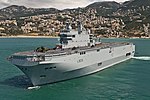
- Mistral-class amphibious assault ship – On board hospital is NATO Echelon level-3,[40] with 69 hospital beds, 7 ICU beds, and an additional 50 beds if needed. The ship also has medical imaging capabilities, such as X-ray, CT-scan and ultrasound.
- Cavour aircraft carrier – Has an on-board hospital with 2 operating rooms, 1 intensive care unit, laboratory, pharmacy and a 32-bed hospital ward.[41]
- Etna logistic ship – On-board hospital is NATO ROLE-level 2+, with operating room, intensive care unit and a laboratory.[42]
- Izumo-class helicopter destroyer – These ships have 2 operating rooms, 2 ICU beds, 35 hospital beds, 1 battle dressing station and several medical imaging (i.e.:X-ray) stations.
- Hyūga-class helicopter destroyer – These ships have 1 operating room, 1 ICU bed, 8 hospital beds.
- Ōsumi-class tank landing ship - These ships have 1 operating room, 2 ICU beds, 6 hospital beds.
- Juan Carlos I – Has a 40-bed hospital on board.[43]

- Royal Fleet Auxiliary ship RFA Argus – This ship would be a hospital ship were it not for its armaments. However, it is instead designated as a 'Primary Casualty Receiving Ship' (PCRS). The vessel is classed as a NATO ROLE 3 Medical support vessel and is to be replaced in 2024[40]
- Royal Fleet Auxiliary Bay Class ships have a 14-bed medical facility which has the capability of being expanded in times of crisis as well as an operating theatre. The vessels are a classed as NATO Role 2 Medical support capable vessels.[40]
- Berlin-class replenishment ship Berlin - Equipped with a container based version of the large modular hospital MERZ which stands for Marineeinsatzrettungszentrum (Englisch: Maritime Rescue Center) capable of holding 45 patients, plus 4 intensive care beds, clinical and microbiological laboratory and sterilisers.[44]
- Berlin-class replenishment ship Frankfurt am Main - Following a fire destroying the Frankfurt's MERZ, the Navy opted to equip the Frankfurt am Main with a new generation integrated MERZ (iMERZ), build into the hull of the ship. It's equipped with two operating rooms, medical imaging capabilities and a hospital ward. The German Navy plans to equip the Frankfurt's two sister ships with an iMERZ during routine maintenance.[45]
See also
[edit]- Lists
- List of hospital ships sunk in World War I
- List of hospital ships sunk in World War II
- List of hospital ships of the Australian Navy
- List of hospital ships of the Brazilian Navy
- List of hospital ships of the Chinese Navy
- List of hospital ships of the Royal Navy
- List of hospital ships of the United States Navy
- List of hospital ships of the United States Army
- List of hospital ships of the United States Sanitary Commission
- Others
- Mercy Ships
- Hospital train
- Hague Convention on Hospital Ships
- Hospital ships designated for the COVID-19 pandemic
- Women on Waves
References
[edit]- ^ Hospital Ship[permanent dead link] (definition via WordNet, Princeton University)
- ^ "Convention (II) for the Amelioration of the Condition of Wounded, Sick and Shipwrecked Members of Armed Forces at Sea: Commentary of 2017, Article 22 : Notification and protection of military hospital ships". International Committee of the Red Cross. 2017. Retrieved 15 October 2019.
- ^ "Convention (II) for the Amelioration of the Condition of Wounded, Sick and Shipwrecked Members of Armed Forces at Sea. Commentary of 2017, Article 31 : Right of control and search of hospital ships and coastal rescue craft". International Committee of the Red Cross. 2017. Retrieved 15 October 2019.
- ^ Pictet, Jean S., ed. (1960). Geneva Convention for the Amelioration of the Condition of the Wounded, Sick and Shipwrecked Members of Armed Forces at Sea (PDF) (in French). Geneva International Committee of the Red Cross.
- ^ Garraud, Dr. Robert M. (1952). Les hapitaux flottants. Vie et Bontk, Paris.
- ^ Grandclment, Vice-Admiral (May 1938). Les navires-hapitaux. Revue internationale de la Croix-Rouge. p. 395.
- ^ a b c d Sutherland Shaw, J.J. (1936). "The Hospital Ship, 1608–1740". The Mariner's Mirror. 22 (4): 422–426. doi:10.1080/00253359.1936.10657206.
- ^ Oppenheim, M. (1896). A History of the Administration of the Royal Navy and of Merchant Shipping in Relation to the Navy. Vol. 1. The Bodley Head. p. 188. OCLC 506062953.
- ^ a b c d Jack Edward McCallum (2008). Military Medicine: From Ancient Times to the 21st Century. ABC-CLIO. pp. 150–152. ISBN 9781851096930.
- ^ Hasted, Edward (1799). "Parishes". The History and Topographical Survey of the County of Kent. 6. Institute of Historical Research: 34–40. Retrieved 28 February 2014.
- ^ "Research guide A6: Greenwich and the National Maritime Museum". Royal Museums Greenwich. Retrieved 12 February 2017.
- ^ Phil Carradice (2013), The Ships of Pembroke Dockyard (e-book), Amberley Publishing, pp. 52–53, ISBN 978-1-4456-1310-9
- ^ a b "Hospital Ships: Introduction". Dartford Hospital Stories. Retrieved 5 November 2021.
- ^ "The Long Reach Hospital Ships - Ghosts of the Dartford Marshes". Remote London. 28 November 2019. Retrieved 5 November 2021.
- ^ "Smallpox Hospital Ships in London". Historic UK. Retrieved 5 November 2021.
- ^ "Medicine and evacuation | Gallipoli | Century Ireland". gallipoli.rte.ie. Retrieved 2024-07-23.
- ^ Douglas N. W. Smith, "Bringing Home the Wounded", Canadian Rail Passenger Yearbook 1996–1997 Edition, Trackside Canada, Ottawa, p. 49-64.
- ^ Popular Science. Bonnier Corporation. August 1927.
- ^ a b c d Condon-Rall, Mary Ellen; Cowdrey, Albert E. (1998). The Technical Services—The Medical Department: Medical Service In The War Against Japan. United States Army In World War II. Washington, DC: Center Of Military History, United States Army. pp. 258, 388–389. LCCN 97022644.
- ^ Johnson, Simon (2010-07-12). "'Floating bunker' plan to help Queen escape nuclear attack". Daily Telegraph. London. Retrieved 2017-08-23.
- ^ "Convention for the adaptation to maritime war of the principles of the Geneva Convention". Yale University. October 18, 1907. Retrieved August 2, 2009.
- ^ "TNI Angkaan Laut". www.tnial.mil.id. Retrieved 2021-07-17.
- ^ "Sudirohusodo-class hospital ship KRI dr. Radjiman Wedyodiningrat joins Indonesia Navy". navyrecognition.com. 20 January 2023. Retrieved 21 November 2023.
- ^ a b "Asian Defence News: Myanmar Commissions Frigate, Hospital Ship". Asian Defence News. 2015-12-30. Retrieved 2020-09-17.
- ^ a b "Eight Naval Ships launched, Myanmar Navy aims to become Blue Water Navy". Global New Light Of Myanmar. 2015-12-24. Retrieved 2020-09-17.
- ^ "Vietnam's naval ship participates in MNEK 2018". People's Army Newspaper. Retrieved 2023-11-25.
- ^ "Hope Floats," interview with Johannes Bernbeck, Ability, accessed 12 September 2011, pp. 26–29.
- ^ "Ship of the Month: Mercy Ships and the Quest to Build Global Mercy". MarineLink. 2021-09-20. Retrieved 2023-02-03.
- ^ John Pike. "World Wide Hospital Ships". globalsecurity.org. Retrieved 4 May 2015.
- ^ "Meet Gerald R. Ford's Senior Medical Officer". ussgeraldrford.wordpress.com. 8 August 2016. Retrieved 5 January 2018.
- ^ "CARRIER . The Ship – PBS". pbs.org. Retrieved 4 May 2015.
- ^ Harwood, Jared L.; Pothula, Viswanadham (April 2011). "The USS George Washington medical department: Medicine in motion" (PDF). Bulletin of the American College of Surgeons. 96 (4): 20–7. PMID 22315888. Archived from the original (PDF) on 19 May 2011.
- ^ "Departments". navy.mil. Archived from the original on 23 April 2015. Retrieved 4 May 2015.
- ^ "USS Wasp". navy.mil. Archived from the original on 20 April 2015. Retrieved 4 May 2015.
- ^ John Pike. "LHD-1 Wasp class". globalsecurity.org. Retrieved 4 May 2015.
- ^ "LHA 6 (formerly LHA(R)) : New Amphibious Assault Ship" (PDF). Dote.osd.mil. Archived from the original (PDF) on 2016-03-04. Retrieved 2016-03-09.
- ^ a b c d "Amphibious Ready Group and Marine expeditionary Unit Overview" (PDF). Imef.marines.mil. Retrieved 2016-03-09.
- ^ "Navantia efectúa con éxito el ´encaje´ del ´Canberra´". laopinioncoruna.es. 4 August 2012. Retrieved 4 May 2015.
- ^ John Pike. "Canberra Class Amphibious Ship". globalsecurity.org. Retrieved 4 May 2015.
- ^ a b c "NATO Logistics Handbook: Chapter 16: Medical Support". nato.int. Retrieved 4 May 2015.
- ^ "Marina Militare » Uomini e mezzi » Cavour". marina.difesa.it. Retrieved 10 April 2018.
- ^ "Marina Militare » Uomini e mezzi » Etna". marina.difesa.it. Retrieved 10 April 2018.
- ^ "The Aviationist » L61 Juan Carlos I". theaviationist.com. Retrieved 4 May 2015.
- ^ "Berlin Class Fleet Auxiliary Vessels". Naval Technology. Retrieved 2023-11-02.
- ^ "Die "Frankfurt am Main" jetzt mit neuem Rettungszentrum - bundeswehr-journal". 2022-05-25. Retrieved 2023-11-02.
![]() This article incorporates text from the public domain Dictionary of American Naval Fighting Ships. The entry can be found here.
This article incorporates text from the public domain Dictionary of American Naval Fighting Ships. The entry can be found here.
External links
[edit]- Australian War Memorial – Sinking of the Centaur Archived 2008-11-21 at the Wayback Machine
- WW2 US Hospital Ships
- US Army Hospital Ships in WWII
- New Zealand Hospital Ships (chapter of official history of WWI)
![]() Media related to Hospital ships at Wikimedia Commons
Media related to Hospital ships at Wikimedia Commons
